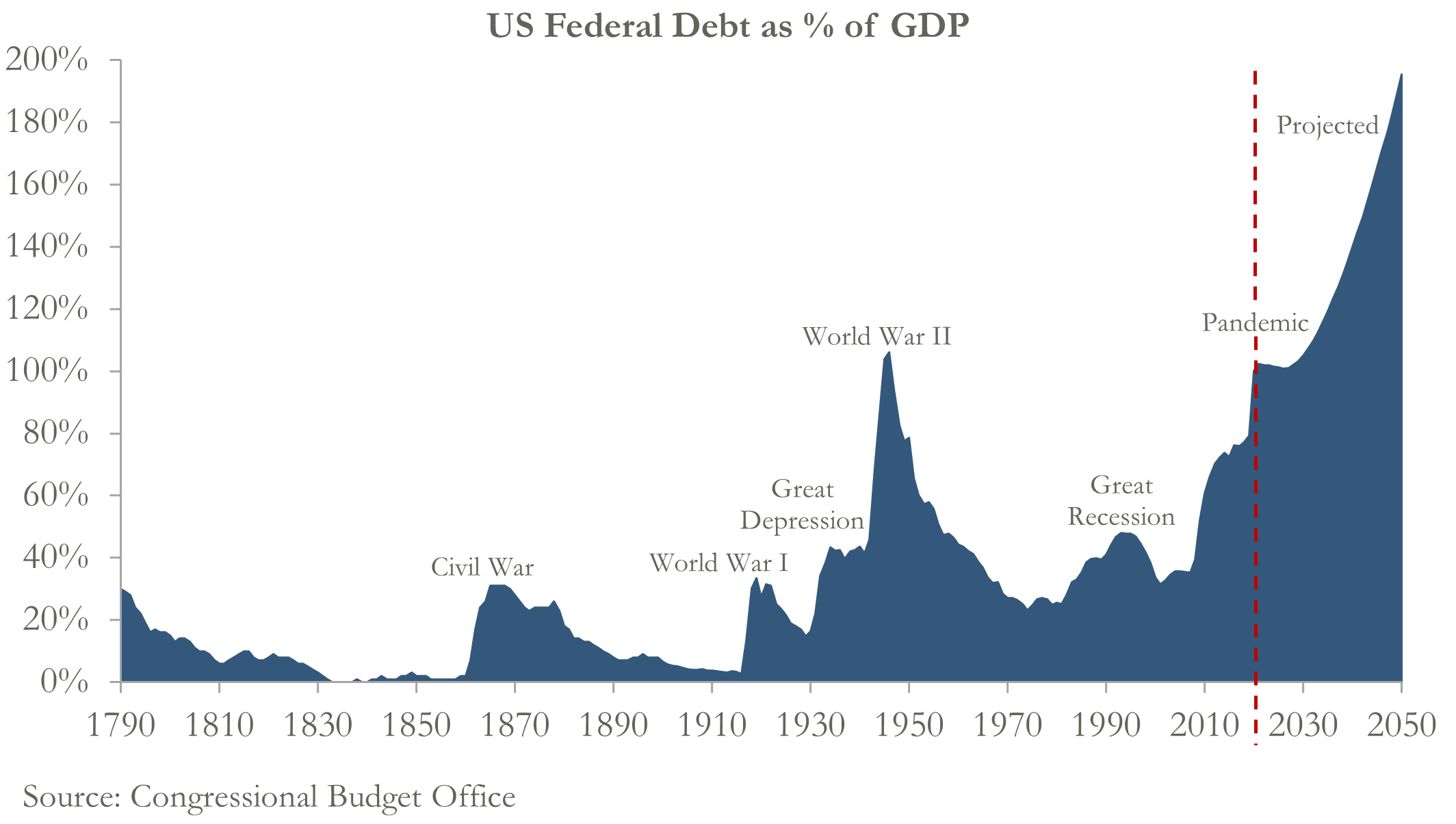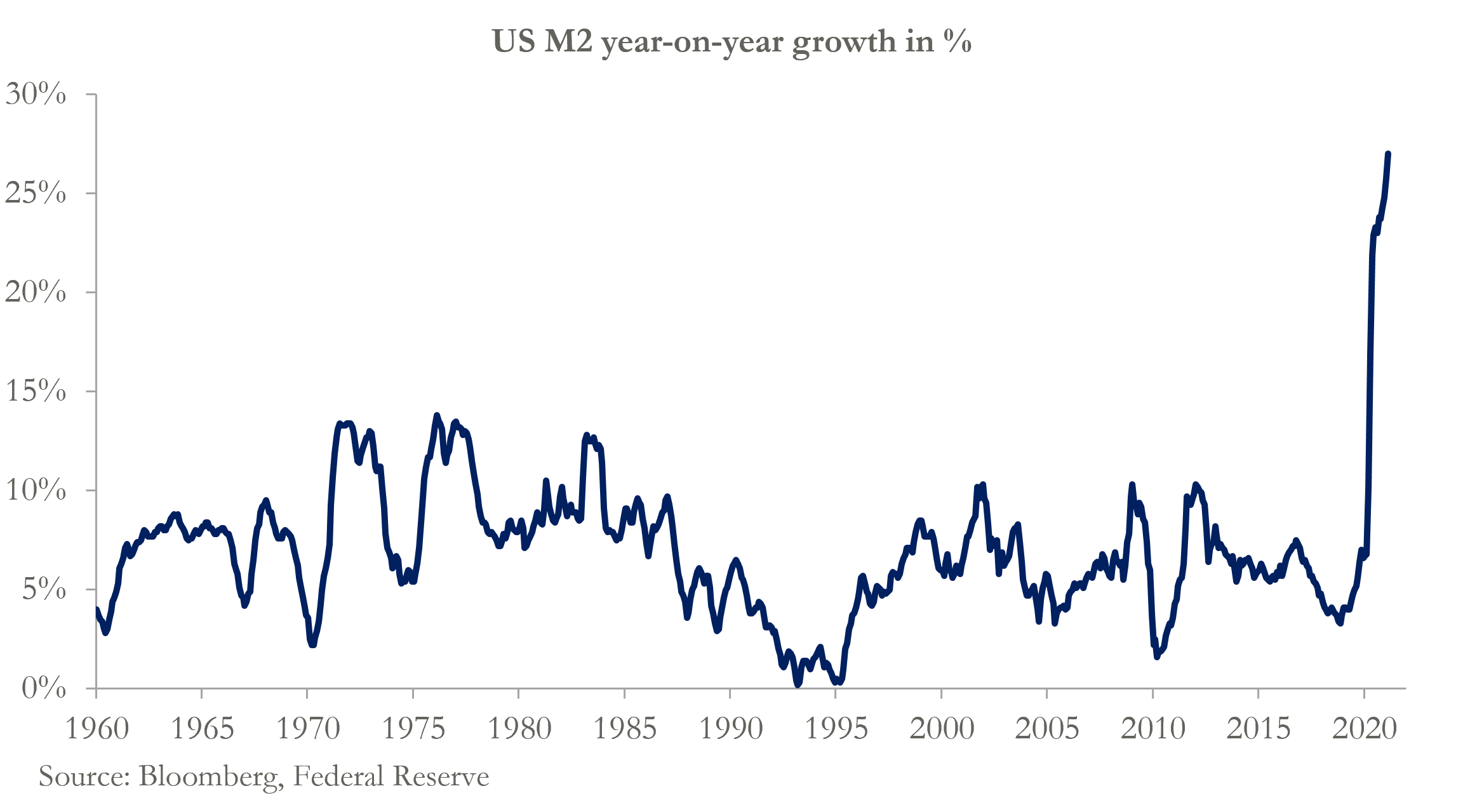Will a “silent tax” solve today’s jaw-dropping debt problem?
To say that
government debt levels are high is nothing new. Even before COVID hit,
despite years of austerity, debt levels were already extremely elevated. But
after the fiscal damage of the pandemic, debt as a percentage of GDP has now
reached jaw-dropping levels, especially when viewed from a long-term historical
perspective. In the US, for example, debt levels haven't been this high since the end of
World War II. And on current projections, debt will skyrocket higher still.

Few would argue that, in the wake of a global pandemic, extraordinary government spending was unjustified. But regardless, this debt must be repaid. The big question for investors is, how?
Looking at the debt situation coldly, without thinking about what is fair or morally right, there are ultimately only four ways to reduce government debt to GDP:
- Default on your debt
- Outgrow your debt
- Raise taxes and/or cut spending
- Inflate the debt away.
Clearly, default is untenable for major developed economies.
We can also discount the second option, which is typically based on hope rather than realism, not least because very high levels of debt are associated with lower rates of growth.
The third option, higher taxes and/or spending cuts, is likely to play some part. But in the current environment, after the years of austerity that followed the GFC, there seems to be little appetite for further large cuts to public spending. Meanwhile, substantially higher taxes are always politically difficult, and even sharp hikes in headline tax rates will not raise the amounts that are necessary. For example, according to a recent op-ed in the Financial Times, raising UK corporation tax from 19% to 24% would theoretically be equivalent to a 0.7% lift in GDP – a drop in the ocean.
This leaves us with the final option which, coincidentally, was the one taken after World War II. According to a 2015 International Monetary Fund working paper by economists Carmen Reinhart and M. Belen Sbrancia, in the period between the end of WWII and the 1970s, advanced economies managed to reduce government public debt from more than 90% of GDP to less than 30%. They did this by allowing higher inflation to persist, while exerting control over nominal interest rates – a practice referred to as "financial repression". Financial repression can take different forms, but its key pillars are:
- Explicit or indirect caps or ceilings on interest rates, for example, central banks' buying longer-dated debt to keep interest rates low.
- The creation of a captive domestic audience of domestic buyers through capital controls or prudential regulatory measures. For example, compelling insurance companies, banks, or pension funds to hold a certain amount of their assets in domestic government debt, despite negative real yields.
- Controlling lending, either through direct ownership of banks or "moral suasion" (the act of persuading a person or group to act in a certain way through rhetorical appeals, persuasion, or implicit and explicit threats).
In the presence of inflation, financial repression would see nominal interest rates held artificially low so that real interest rates are negative, which over time has the effect of lowering government debt levels. Alternatively, real rates are positive but still artificially lower than the rates governments would ordinarily have borrowed at, thus imposing a financial repression ‘tax’ on debt holders.
Of course, to accomplish this, governments and central banks must first generate the inflation needed, and in recent years this has been easier said than done. Factors such as globalisation and rapid technological advances have proven to be formidable headwinds, depressing the prices of goods and wages, and thwarting central banks’ efforts. Even the act of "printing money" through QE after the 2008 financial crisis failed to achieve inflation, despite many warnings at the time that these unconventional measures would lead us down a path of Weimar-style hyperinflation.
However, there are some reasons to believe this time could be different.
- In the post-2008 era, easy monetary policy was offset by fiscal austerity. This time, however, fiscal and monetary policy are both pulling in the same direction. The numbers are also astronomical. Even former US Treasury Secretary Larry Summers, an influential Harvard economist and policymaker, who for years has argued for more reliance on active fiscal policy, expressed concern that what is being done is “substantially excessive”, calling it the “least responsible fiscal policy in the last 40 years”.
- This extraordinary monetary and fiscal stimulus comes at a time when households have accumulated large savings during lockdowns. As economies are reopened, they are expected to greatly increase spending.
- Governments have succeeded - where repeated rounds of QE failed - in sparking rapid growth in broader money. This is illustrated by the chart below, which shows so-called M2 in the US, representing not just physical money in circulation, but also balances in checking accounts, short-term time deposits, and retail money market funds. This growth was achieved through the various government credit guarantee or subsidy schemes, examples being the Paycheck Protection Program in the US, the Coronavirus Business Interruption Loan Scheme in the UK, or the Coronavirus SME Guarantee Scheme in Australia.
In a modern fractional banking system, it is commercial banks, not central banks, that really create most "money", through lending. And where QE failed to convince banks to lend, government credit guarantees have succeeded.

- Finally, central banks have recently made it clear that they are willing to risk inflation overshooting their targets to make up for years of below-target inflation. For example, in 2020 the US Fed, in a major shift of policy, changed to an ‘average’ inflation target over a cycle (without defining the horizon). Meanwhile, the RBA has insisted it will not raise rates until it sees wage growth sustainably above 3%.
Whether or not central banks will succeed in
generating sustained inflation, after failing to do so for over a decade, is
unclear. But if they do, it seems likely that the solution to today’s
wartime-like levels of debt will be the very same strategy used after the guns fell silent post-World War II: a silent long-term tax on savers.
Never miss an insight
Enjoy this wire? Hit the ‘like’ button to let us know. Stay up to date with my content by hitting the ‘follow’ button below and you’ll be notified every time I post a wire. Not already a Livewire member? Sign up today to get free access to investment ideas and strategies from Australia’s leading investors.
3 topics
1 stock mentioned

